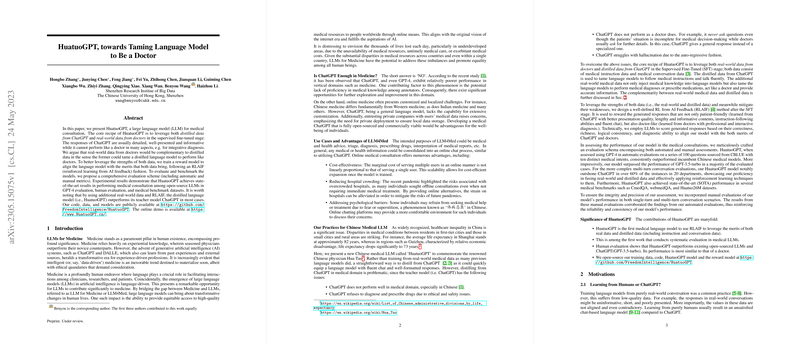An Analysis of HuatuoGPT: A Medical LLM
The paper introduces HuatuoGPT, a LLM designed specifically for medical consultation. The development and training of HuatuoGPT leverage both distilled data from ChatGPT and real-world data from medical professionals. This combination aims to address the limitations of existing models in integrating detailed, fluent responses with diagnostic accuracy.
Model Development Approach
The core methodology involves a hybrid data strategy during the supervised fine-tuning (SFT) phase. Distilled data from ChatGPT contribute by providing fluency and comprehensive communication style, whereas real-world data from doctors enhance diagnostic precision and professional alignment with medical practices. This dual data leverage seeks to mitigate the insufficiencies seen in ChatGPT's generalized responses, which often exclude specific diagnostic questions crucial in medical contexts.
To further align HuatuoGPT with both patient-friendly and doctor-like responses, the model is integrated with a Reinforced Learning from AI Feedback (RLAIF) protocol. The reward model is trained to balance correctness, informativeness, logical consistency, and diagnostic capability, effectively overcoming typical auto-regressive LLM issues such as hallucination and non-inquisitive responses.
Evaluation and Results
The evaluation framework employs a combination of automatic and manual metrics across various benchmarks, including CBLUE, CmedQA, webMedQA, and Huatuo26M datasets. In these assessments, HuatuoGPT demonstrates state-of-the-art performance in medical consultation tasks, surpassing both open-source models and the baseline ChatGPT in several domains.
Key numerical results include:
- Superior performance in Chinese medical QA datasets like cMedQA2, with notable gains in BLEU, ROUGE, and distinct metrics.
- GPT-4 and human evaluators confirm HuatuoGPT's preference over GPT-3.5-turbo in over 60% of evaluated cases, showcasing its adept integration of diagnostic proficiency and conversational fluency.
Implications and Future Directions
The implications of HuatuoGPT extend to practical healthcare applications, where equitable access to medical expertise can be significantly enhanced via online platforms. This functionality is crucial in addressing healthcare disparities, particularly in under-resourced regions.
On a theoretical level, HuatuoGPT offers insights into integrating LLMs with domain-specific expertise, emphasizing the possible transformation that LLMs can bring to medical domains. This aligns with the broader trend of ‘intelligent medicine,’ poised to redefine traditional healthcare delivery.
Future developments could explore fine-tuning advancements to further improve HuatuoGPT’s diagnostic capabilities. Additionally, expanding the model’s database to include more diverse healthcare practices, like indigenous medicine systems, might fortify its adaptability across varying cultural contexts. The paper also highlights ethical considerations, emphasizing the importance of accuracy and responsibility when deploying AI in healthcare.
In summary, HuatuoGPT is a compelling model that bridges the gaps between state-of-the-art LLMs and the nuanced demands of medical diagnostics. Its development and fine-tuning approaches set a precedent for future AI applications in specialized domains, promising significant advancements in both AI research and practical, real-world implementations.
